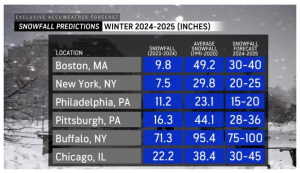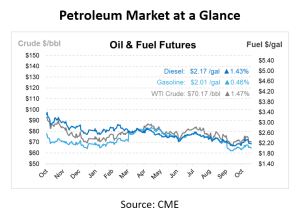
Winter 2024-25 – What to Expect?
As the days get shorter and the air turns chilly, weather experts are already studying patterns to predict what the season will bring. With meteorological winter starting on December 1, early winter forecasts suggest a mix of warm spells and cold blasts, along with changing precipitation across the country.
Insights from AccuWeather, the Farmers’ Almanac, the National Oceanic and Atmospheric Administration (NOAA), and the U.S. Energy Information Administration (EIA), indicate that the Winter 2024-25 season will again test our readiness for the ups and downs that lie ahead.
Above-normal snowfall
According to NOAA, the Northwest is likely to see above-normal snowfall. In contrast, the Southwest may experience below-normal precipitation. The Northern Plains and Great Lakes regions are forecasted to have increased snowfall, while the Northeast could also benefit from above-normal precipitation. Overall, a weak La Niña is anticipated, which typically brings wetter conditions to the north and drier conditions to the south, influencing snowfall patterns across the country.

AccuWeather’s insights suggest that the upcoming winter will largely mirror last year, which was the warmest on record for much of the US. However, there will be periodic blasts of cold air leading to increased snowfall in certain regions. According to AccuWeather Senior Meteorologist Paul Pastelok, one of the major elements influencing the forecast is the anticipated weak La Niña, which occurs when water temperatures near the equator in the eastern Pacific remain below average for an extended period. This phenomenon significantly influences weather patterns across North America, including the trajectory of snowstorms. A weaker La Niña can create more variability in weather patterns, allowing both warmer and colder conditions to affect the season.

The Farmers’ Almanac offers a different outlook, predicting a “wet winter whirlwind” characterized by rapid-fire storms delivering both rain and snow. According to the Farmers’ Almanac, the coldest temperatures will be concentrated in the Northern Plains and the Great Lakes, particularly during the last week of January into early February. They anticipate that winter in New England and the Northeast will be stormy, with above-normal winter precipitation expected, especially in interior and mountainous areas, while the coastal regions are likely to see more sleet and rain.

Energy Consumption and Heating Costs
According to the U.S. Energy Information Administration (EIA), conditions may influence temperatures and precipitation across the country, with a season characterized by fluctuating temperatures and variable precipitation patterns, particularly as some regions may experience milder conditions while others brace for snow and colder temperatures. The expected milder conditions across the southern and central US could also lead to lower heating demand, potentially translating to reduced heating bills. However, this warmth could be coupled with drier conditions, raising the risk of drought in states like Alabama, Mississippi, and Louisiana. Moreover, when storms do roll through, the EIA warns of a heightened risk of severe weather due to the overall mild conditions and the warm, humid air from the Gulf of Mexico.
To add another layer to the winter forecast, EIA’s Winter Fuels Outlook analyses energy consumption and heating costs. According to the EIA, most US households are expected to spend about the same or even less on heating this winter compared to last year. However, the Midwest is projected to see an increase in heating expenditures of between 2% and 11% due to a return to more typical temperatures. The EIA forecasts a 5% increase in natural gas consumption across the country, while also projecting a 4% decrease in natural gas prices, which may lead to changes in overall heating bills.
Heating oil, a variation of distillate fuel oil or diesel, is the primary heating fuel for 4% of US households. For those using this fuel, particularly in the Northeast, the forecast indicates an average household will spend about 5% less on heating oil this winter than last year, despite consuming more due to colder weather. The EIA suggests that warmer weather could lead to lower expenditures on heating oil, while colder weather may increase costs despite lower prices. This complex interplay of temperature and pricing means that consumers will need to plan accordingly.

As the season progresses, we encourage you to stay informed on updated weather forecasts, which will help you stay prepared to navigate the dynamic conditions winter usually brings.
Talk to the Specialist
Mansfield Energy offers extensive coverage and has a proven track record of delivering effective solutions for businesses facing winter fueling challenges. Mansfield’s Arsenal ColdPRO is a program to improve your fuel’s cold-weather performance, offering consistent and accurate treatments, minimizing kerosene cost, and performing nationwide fuel testing.
Implementing Mansfield’s Arsenal ColdPRO ensures your fuel systems operate efficiently throughout the winter season. If you haven’t already, reach out to Mansfield to learn more about Arsenal Cold Pro. Don’t wait; contact us today to secure a worry-free winter for your fuel needs.

This article is part of Daily Market News & Insights
MARKET CONDITION REPORT - DISCLAIMER
The information contained herein is derived from sources believed to be reliable; however, this information is not guaranteed as to its accuracy or completeness. Furthermore, no responsibility is assumed for use of this material and no express or implied warranties or guarantees are made. This material and any view or comment expressed herein are provided for informational purposes only and should not be construed in any way as an inducement or recommendation to buy or sell products, commodity futures or options contracts.





